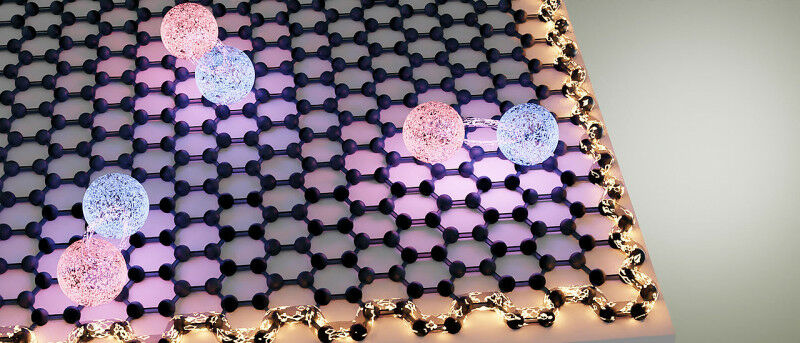博文
光驱动电子产品的里程碑
||
光驱动电子产品的里程碑
诸平
据德国维尔茨堡大学(University of Würzburg / Universität Würzburg)2023年1月10日报道,一个由德国、波兰、意大利以及美国研究人员组成的研究团队,在维尔茨堡大学的维尔茨堡-德累斯顿卓越集群(Würzburg-Dresden Cluster of Excellence ct.qmat)的框架内,激子(excitons)首次在拓扑绝缘体中产生,这是一项基于维尔茨堡大学材料设计的量子研究突破(Milestone for light-driven electronics)。上图是拓扑绝缘体铋上的3个激子(由一个电子和一个电子空穴组成的对)。由于蜂窝状原子结构,电子只能沿着边缘流动。
在维尔茨堡-德累斯顿卓越集群内合作的国际科学家团队,在量子研究方面取得了突破——首次检测到拓扑绝缘体(topological insulator)中的激子(电中性准粒子)。这一发现为新一代光驱动计算机芯片和量子技术铺平了道路。由于拓扑绝缘体的发源地维尔茨堡的智能材料设计,它得以实现。相关研究结果于2023年10月23日已经在《自然通讯》(Nature Communications)杂志网站发表——Marcin Syperek, Raul Stühler, Armando Consiglio, Paweł Holewa, Paweł Wyborski, Łukasz Dusanowski, Felix Reis, Sven Höfling, Ronny Thomale, Werner Hanke, Ralph Claessen, Domenico Di Sante, Christian Schneider. Observation of room temperature excitons in an atomically thin topological insulator. Nature Communications, Published: 23 October 2022, Volume 13, Article number: 6313. https://www.nature.com/articles/s41467-022-33822-8
参与此项研究的有来自波兰弗罗茨瓦夫科技大学(Wrocław University of Science and Technology, Wybrzeże Wyspiańskiego, Wrocław, Poland)、德国维尔茨堡大学物理研究所和维尔茨堡-德累斯顿卓越集群(Physikalisches Institut and Würzburg-Dresden Cluster of Excellence ct.qmat, Universität Würzburg, Würzburg, Germany)、德国维尔茨堡大学理论物理学和天体物理学研究所及维尔茨堡-德累斯顿卓越集群(Institut für Theoretische Physik und Astrophysik and Würzburg-Dresden Cluster of Excellence ct.qmat, Universität Würzburg, Würzburg, Germany)、德国奥尔登堡大学(University of Oldenburg, Germany);意大利博洛尼亚大学(University of Bologna, Italy)及美国纽约的熨斗研究所(Flatiron Institute, New York, USA)的研究人员。
固态物理学的新工具箱(New toolbox for solid state physics)
在为未来的量子技术寻找新材料时,位于维尔茨堡和德累斯顿的两所大学的卓越集群 (Cluster of Excellence ct.qmat)-量子物质的复杂性和拓扑学-的科学家们正在关注的一个领域是拓扑绝缘体(topological insulators),它使无损传导电流和稳健的信息存储成为可能。这种材料类别的首次实验实现于2007年在维尔茨堡进行,推动了世界范围内固态物理学的研究热潮,这种热潮一直持续到今天。
以前使用拓扑绝缘体的概念是基于施加电压以控制电流——这是传统计算机芯片采用的一种方法。然而,如果奇异材料特性基于电中性粒子(既不带正电也不带负电),则电压不再起作用。因此,如果要产生这种量子现象,就需要其他工具——例如光。
光学和电子学通过量子现象联系在一起(Optics and electronics are linked by a quantum phenomenon)
由来自维尔茨堡大学的量子物理学家、卓越集群(ct.qmat)的联合发言人拉尔夫·克莱森(Ralph Claessen)教授领导的国际研究团队现已取得一项重要发现。正如拉尔夫·克莱森教授强调的那样:“这是我们第一次能够在拓扑绝缘体中生成并通过实验检测被称为激子的准粒子。因此,我们创建了一种新的固态物理学工具箱,可用于光学控制电子。这一原理可能成为新型电子元件的基础。”
激子是电子准粒子。尽管它们看起来像独立的粒子,但它们实际上代表了一种只能在某些类型的量子物质中产生的激发电子态。“我们通过将短光脉冲应用于仅由一层原子组成的薄膜来产生激子,”拉尔夫·克莱森解释说。他说,这有什么不寻常之处在于激子在拓扑绝缘体中被激活——这在以前是不可能的。“这为拓扑绝缘体开辟了一条全新的研究路线,”拉尔夫·克莱森补充道。
大约十年来,激子一直在其他二维半导体中进行研究,并被视为光驱动组件的信息载体。“这是我们第一次设法在拓扑绝缘体中光学激发激子。光与激子之间的相互作用意味着我们可以期待在这种材料中出现新现象。例如,可以使用该原理来生成量子比特(qubits),”拉尔夫·克莱森说。
量子比特是量子芯片的计算单元。它们远远优于传统的比特,可以在几分钟内解决传统超级计算机实际上需要数年才能完成的任务。使用光而不是电压可以使量子芯片的处理速度快得多。因此,最新发现为未来的量子技术和微电子领域的新一代光驱动设备铺平了道路。
来自维尔茨堡的全球专业知识(Global expertise from Würzburg)
正确的起始材料至关重要-在本例中为含铋碳化硅(bismuthene,Bi/SiC)。“它是神奇材料石墨烯的沉重兄弟姐妹,”拉尔夫·克莱森说,他五年前在实验室首次定制了拓扑绝缘体。“我们是该领域的全球领导者,”他补充道。“由于我们精密的材料设计,单层Bi/SiC的原子排列成蜂窝状,就像石墨烯一样。不同之处在于,Bi/SiC的重原子使其成为拓扑绝缘体,这意味着它可以沿边缘无损耗地导电- 即使在室温下。石墨烯无法做到这一点。”
可以参看动画片:Bi/SiC上的光脉冲产生激子对,激子对穿过二维超薄材料层(Animation: A light pulse on bismuthene generates exciton pairs that move through the two-dimensional ultrathin layer of material.)。
潜力巨大(Huge potential)
现在研究团队首次在拓扑绝缘体中产生了激子,注意力正转向准粒子本身。卓越集群(ct.qmat)的科学家正在研究Bi/SiC的拓扑特性是否会转移到激子上。科学地证明这一点是研究人员关注的下一个里程碑。它甚至可以为构建拓扑量子比特铺平道路,与非拓扑量子比特相比,拓扑量子比特被认为特别稳健。
国际合作(International cooperation)
这些发现来自意大利博洛尼亚大学、波兰弗罗茨瓦夫科技大学、美国纽约熨斗研究所、德国奥尔登堡大学和维尔茨堡大学的科学家之间的密切合作。二维铋材料样品是在 JMU Würzburg 生产的。
导致这些结果的研究得到了欧盟地平线2020研究和创新计划的资助(European Union’s Horizon 2020 research and innovation program under the Marie Skłodowska-Curie Grant Agreement No. 897276)。也得到了德国研究基金会(Deutsche Forschungsgemeinschaft简称DFG)在德国卓越战略下通过维尔茨堡-德累斯顿量子物质复杂性和拓扑卓越集群提供的资金支持{ Deutsche Forschungsgemeinschaft (DFG, German Research Foundation) under Germany’s Excellence Strategy through the Würzburg-Dresden Cluster of Excellence on Complexity and Topology in Quantum Matter ct.qmat (EXC 2147, Project ID 390858490) as well as through the Collaborative Research Center SFB 1170 ToCoTronics (Project ID 258499086)}。还有波兰国家科学中心{Polish National Science Center within the Etiuda 8 scholarship (Grant No. 2020/36/T/ST5/00511);Polish National Science Center within the Opus 18 Grant No.2019/35/B/ST5/04308}、波兰国家学术交流机构{Polish National Agency for Academic Exchange (PPI/APM/2018/1/00031/U/001)}以及西蒙斯基金会(Simons Foundation)的支持。
上述介绍,仅供参考。欲了解更多信息,敬请注意浏览原文或者相关报道。
Optical spectroscopy of ultimately thin materials has significantly enhanced our understanding of collective excitations in low-dimensional semiconductors. This is particularly reflected by the rich physics of excitons in atomically thin crystals which uniquely arises from the interplay of strong Coulomb correlation, spin-orbit coupling (SOC), and lattice geometry. Here we extend the field by reporting the observation of room temperature excitons in a material of non-trivial global topology. We study the fundamental optical excitation spectrum of a single layer of bismuth atoms epitaxially grown on a SiC substrate (hereafter bismuthene or Bi/SiC) which has been established as a large-gap, two-dimensional (2D) quantum spin Hall (QSH) insulator. Strongly developed optical resonances are observed to emerge around the direct gap at the K and K’ points of the Brillouin zone, indicating the formation of bound excitons with considerable oscillator strength. These experimental findings are corroborated, concerning both the character of the excitonic resonances as well as their energy scale, by ab-initio GW and Bethe-Salpeter equation calculations, confirming strong Coulomb interaction effects in these optical excitations. Our observations provide evidence of excitons in a 2D QSH insulator at room temperature, with excitonic and topological physics deriving from the very same electronic structure.
https://blog.sciencenet.cn/blog-212210-1371576.html
上一篇:癌症之谜解开:科学家发现黑色素瘤肿瘤如何控制死亡
下一篇:MIT发现可以解锁更安全、更轻的锂电池
